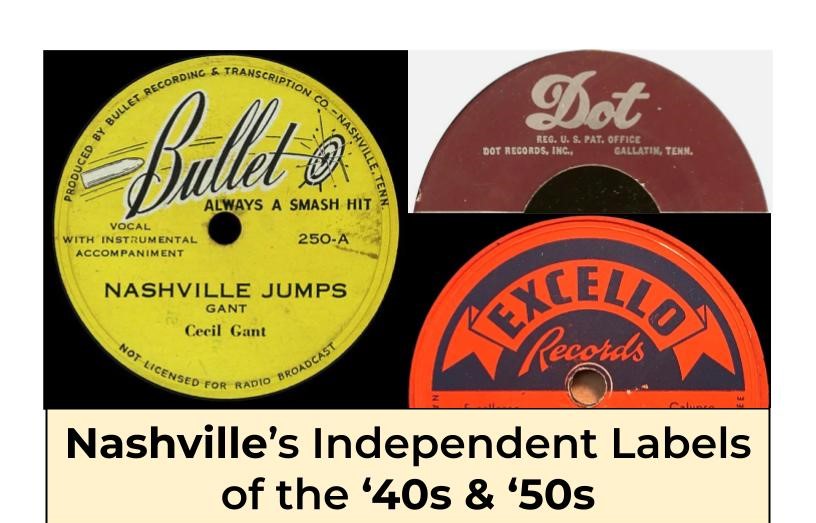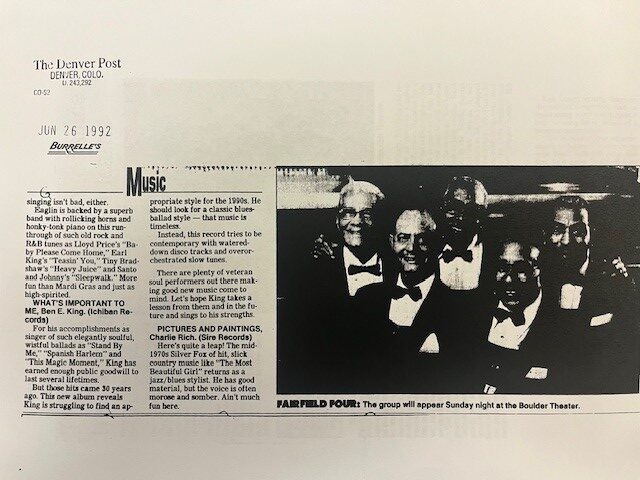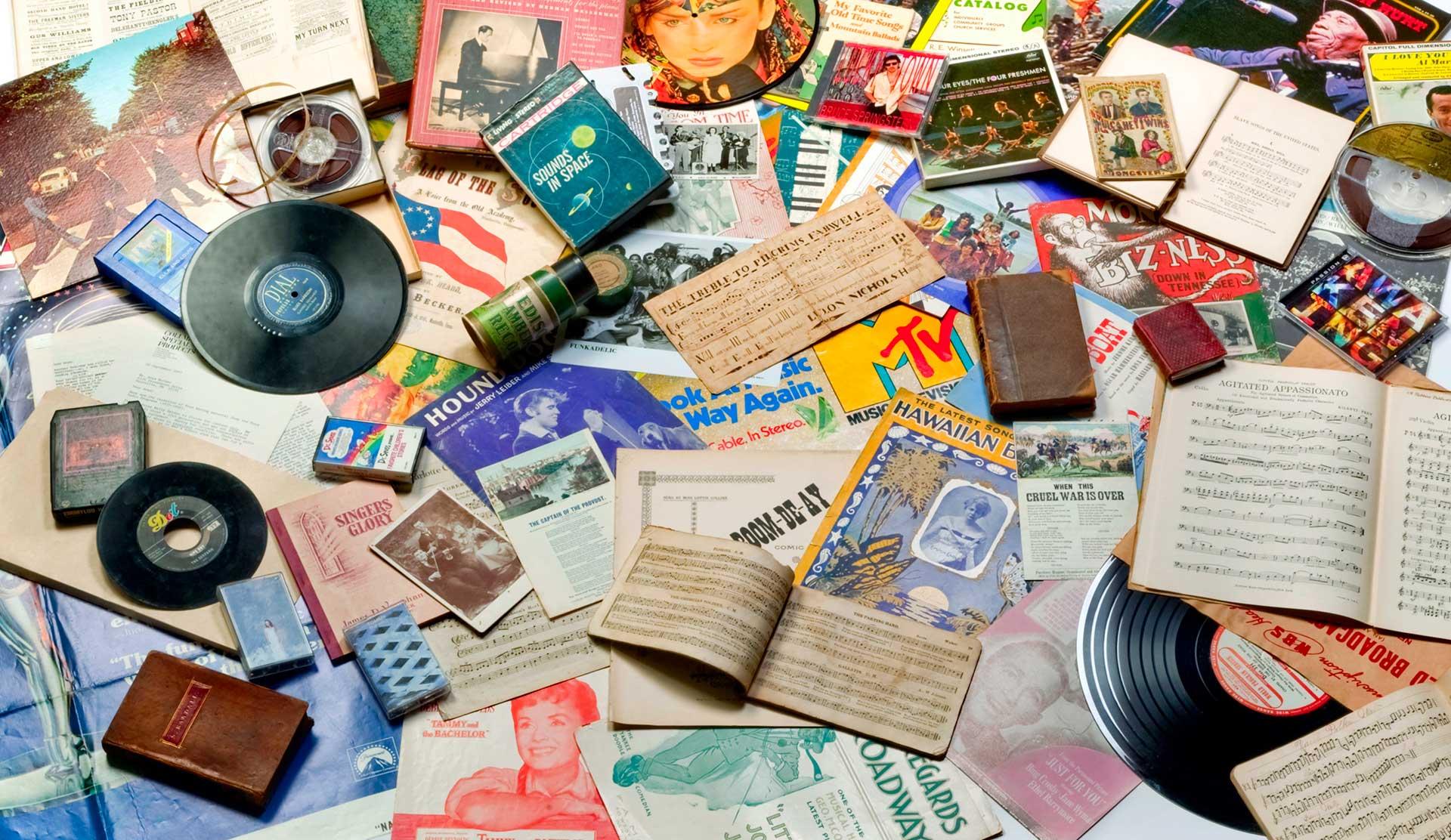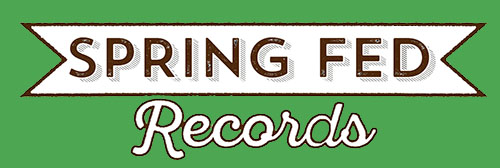Center for Popular Music
Nashville Independent Record Labels of the 1940s and 1950s
Exhibit Spotify Playlist and Annotated Bibliography

Here is a companion playlist and an annotated bibliography of books and vertical files you can find in the CPM Reading Room that are connected to the Nashville’s Independent Labels of the ’40s & ’50s exhibit.
Reading Room Books

The MTSU community will recognize the name of Clay Tucker in association with the Tucker Theatre named for him and his wife, Dorethe, an avid supporter of the performing arts. In 1971, Dr. Clay Tucker became acting Head of the new Philosophy Department. The next year he would become the first Dean of the College of Liberal Arts. However, this edited volume represents his active participation in the history of Nashville’s big band orchestras. Tucker played trumpet in high school and in the United States Navy, before returning to Nashville and playing principally with Tom Hewgley. Co-author PJ (Paul) Broome worked for years at the registration desk of the upscale Tulane Hotel, where many a traveling musician passed through. Playing drums since childhood, he played with Alvino Rey’s Navy Band in Chicago in the 1940s, before returning to Nashville to play under Ben Brasselle, Karl Garvin, Papa John Gordy, and Tommy Knowles, among others.

As a member of The Casuals, one of Nashville’s first white rock and roll groups in the 1950s, James “Buzz” Cason (1939-2024) left a lasting mark on the Nashville musical scene through performance, songwriting, publishing, and as a studio owner. On national package tours, Cason would perform under the persona of Garry Miles, under his own name as singer for The Casuals, and also as a backup vocalist for Brenda Lee, all in the same show. As a songwriter he started young, writing for Ernie Young’s Excello and Nasco labels in the late ‘50s as well as local celebrity DJ, Noel Ball. He often sang on many soundalike records in the 1960s due to his wide vocal range and styles. With co-writer and fellow Nashville rock and roll guitarist Mac Gayden, Cason penned “Everlasting Love,” a song which has gone #1 in every decade since it was first recorded by local singer, Robert Knight. With Bobby Russell, Buzz Cason had a publishing and independent record label in the late 1960s, which eventually led to him opening Creative Workshop, the first recording studio in Nashville’s Berry Hill neighborhood. Workshop. This studio later attracted others to create a new center of recording in Nashville.
This reference volume includes information for Julian “Matty” Matlock, Nashville clarinet player on page 325. Matlock played for Beasley Smith in Nashville before eventually working for Bob Crosby’s orchestra in Los Angeles.

Fox, Randy. Shake Your Hips : The Excello Records Story. RPM Series. New York, NY: BMG, 2018.
Moving to Nashville in the 1980s, Randy Fox immediately began writing about the impact of local music scenes for independent outlets, a practice he continues today with The Nashvillian, as managing editor. His knowledge of the 1950s and 1960s musical landscape in Nashville led to this book about the lasting impact of local record pioneer Ernie Young and his Nashboro family of records labels, which featured genres like blues, piano-oriented R&B, and early elements of what would become considered rock and roll. This label recorded a wealth of local talent that Fox explores in depth from Black boogie to the white doo-wop on the Nasco imprint.

This book is an academic history of country music label, Starday Records. The label started in Beaumont, Texas in 1952, and a series of business decisions provided an impetus for a split among the initial ownership. Don Pierce, who previously had run the short-lived country label Four Star, moved Starday to Madison, a suburban neighborhood of Nashville, in the late 1950’s. Focusing on country music almost exclusively, Starday also maintained a catalog of rockabilly and built its own studio on Dickerson Pike. It later became the home of Starday-King records, absorbing the famous Cincinnati label. Weathering the influence of rock and roll and later the Nashville sound, Starday played an integral part in the preservation of traditional country music, with a studio that also served Nashville. Longtime producer and studio engineer at Starday, Tommy Hill, also worked on the Nashville independent Hickory Records label, created by the publishing company Acuff-Rose.

Financed by the Country Music Foundation and Vanderbilt University Press, this book represents decades of research by author Martin Hawkins. Beginning with the early small and short-lived independent labels of Nashville (Often releasing just a handful of 78s.), most of the chapters cover the impact of Bullet Records, which released both white and Back artists. Many artists on Bullet’s roster had origins in Nashville. A Shot in the Dark also chronicles the rise of Dot Records, from Randy’s Record Shop in Gallatin, and the Nashboro family of labels, from Ernie’s Record Mart in Nashville and explores the legacy of these independent labels that formed the foundation of what became “Music City”.

A product of personal and professional fascination, this monograph from Dr. Robert W. Ikard examines the role played by Francis Craig and the early big band orchestras in bringing Nashville music to the world, not through three chords and the truth, but via piano and large group arrangements. The song “Near You,” which is actually the B-side to Francis Craig’s theme song “Red Rose,” exploded in 1947. It eventually became a national hit for several other performers including Alvino Rey, The Andrews Sisters (A popular war-time singing group), Larry Green (an orchestra leader and piano player of “sweet music” rather than swinging styles) and Elliot Lawrence (Jazz pianist and bandleader). Ikard explains how Craig, bandleader of the house band at the Hermitage Hotel Grill Room and a participant in the initial launch of WSM Radio, also helped kickstart the careers of Dinah Shore, Snooky Lanson and others. His hit record helped local independent label Bullet Records find national prestige and financial stability, supporting its “Sepia” series of records that notably started with Cecil Gant and his “Nashville Jumps” single.
This reference book contains a discography of over 100 recordings of Cecil Gant, who was famous for the songs “Nashville Jumps” and “I Wonder” on Bullet Records on pages 444-448.

This hard-to-find book delves into the various contextual environments that generated the popular music genres we know today. Related to Nashville’s early independent labels, the authors explore the arrival of Ralph Peer to Nashville for the first recording sessions in Nashville in 1928 with the Gully Jumpers. The book’s coverage of the start of the Grand Ole Opry includes references to initially negative local opinion, as well as the stages of its development and interaction with local musicians (Pages 180-183). Chapters on the national significance of Francis Craig (Page 205) as well as Dinah Shore (Page 222) discuss the influence of Nashville’s record labels alongside mentions of Cecil Gant (Pages 425-6) who helped launch the club combo scene on the West Coast. Mancuso places Gant in context alongside Nat King Cole and Ivory Joe Hunter. Popular Music and the Underground also explores the crossover of black pianist-singer Ivory Joe Hunter from R&B to country as well as his late 1950s connection to local independent label, Dot Records (Page 427)

Sharp, Timothy W. Nashville Music Before Country. Charleston, SC: Arcadia Pub., 2008.
Nashville Music Before Country sets the stage for the history of the music publishing industry in Nashville prior to recorded sound. The book’s in-depth look at migration patterns helps position folk sounds from the British Isles alongside classical influences from German immigrants and African American spirituals and gospel songs that ultimately transform into sounds that are recognized today. Its author Tim Sharp, the Dean of Fine Arts at Memphis’ Rhodes College, has written extensively on Tennessee musical traditions from Memphis to the mountains. The book, in particular, examines the intersection of entertainment, education, and music publishing in Middle Tennessee as the background for the industry that eventually blossoms from these roots.

In this book on the early days of artist and repertoire (A&R) talent scouting, Brian Ward and Patrick Huber provide considerable space to the Nashville music scene including the post-war recording industry in the 1940s and 1950s. Chapter 8, entitled “Nowhere Near Total Eclipse: A&R Work After World War II” (pages 265-312) explores the independent labels in Nashville and the rise of the studios that also fed larger national labels. Notably, the early WSM Opry star DeFord Bailey’s recordings on Victor for Ralph Peer receive attention for their cross-listing on both race and hillbilly series of records (Pages 225-228). They represent the first recordings done in Nashville.
Reading Room Vertical Files

Cason, Buzz
Press clippings for Buzz Cason can be found in the “CARS-CAZ, Misc.” folder.
Articles
Ghianni, Tim. “Fond memories color Cason’s ‘Rock’n’roll Dream. ’The Tennessean. April 20, 2004, 1D.
Goldsmith, Thomas. “Multi-talented Buzz Cason taking it to the streets.” The Tennessean. January 5, 1986. Showcase section.
Marx, Jonathan. “Buzz Words: Music City veteran Buzz Cason publishes autobiography charting his varied career.” The Nashville Scene. April 22, 2004

Fairfield Four
This folder contains numerous newspaper articles, related to awards and obituaries, as well as copies of funeral programs.
Articles
Gray, Michael. “Cafe crowd touched by the spirit of Fairfield Four’s gospel.” Nashville Banner. October 2, 1997. D-6.
Orr, Jay. “Fairfield 4 to join ‘Legends.’ The Tennessean. March 7, 1998, 6B.
Schmitt, Brad “The Bus Driver with a Grammy.” The Tennessean. Feb 23, 2016.
Thanki, Juli. “Fairfield Four, McCrarys keep rare style alive.” The Tennessean. April 5, 2015. 8E – 9E.
Obituaries
Isaac “Dickie’ Freeman (1928-2012; member 1948-50; 1980-2012)
Robert Hamlett (1931-2016; member 1984-2016)
James Hill ( 1916-2000; member 1946-1950, 1980-2000)
Walter Settles (1928-1999; member 1991-1995)
Wilson ‘Lit’ Waters Jr. (1930-2005; member 1982-2005)
Funeral Programs
James Samuel Hill, 1916-2000
Walter James Settles, Jr., 1928-1999
By Jon Sewell (Edits/formatting by Logan Dalton)
Contact Us
Center for Popular Music
Bragg Media & Entertainment Bldg.
Room 140
MTSU Box 41
1301 E. Main Street
Middle Tennessee State University
Murfreesboro, TN 37132
615-898-2449




